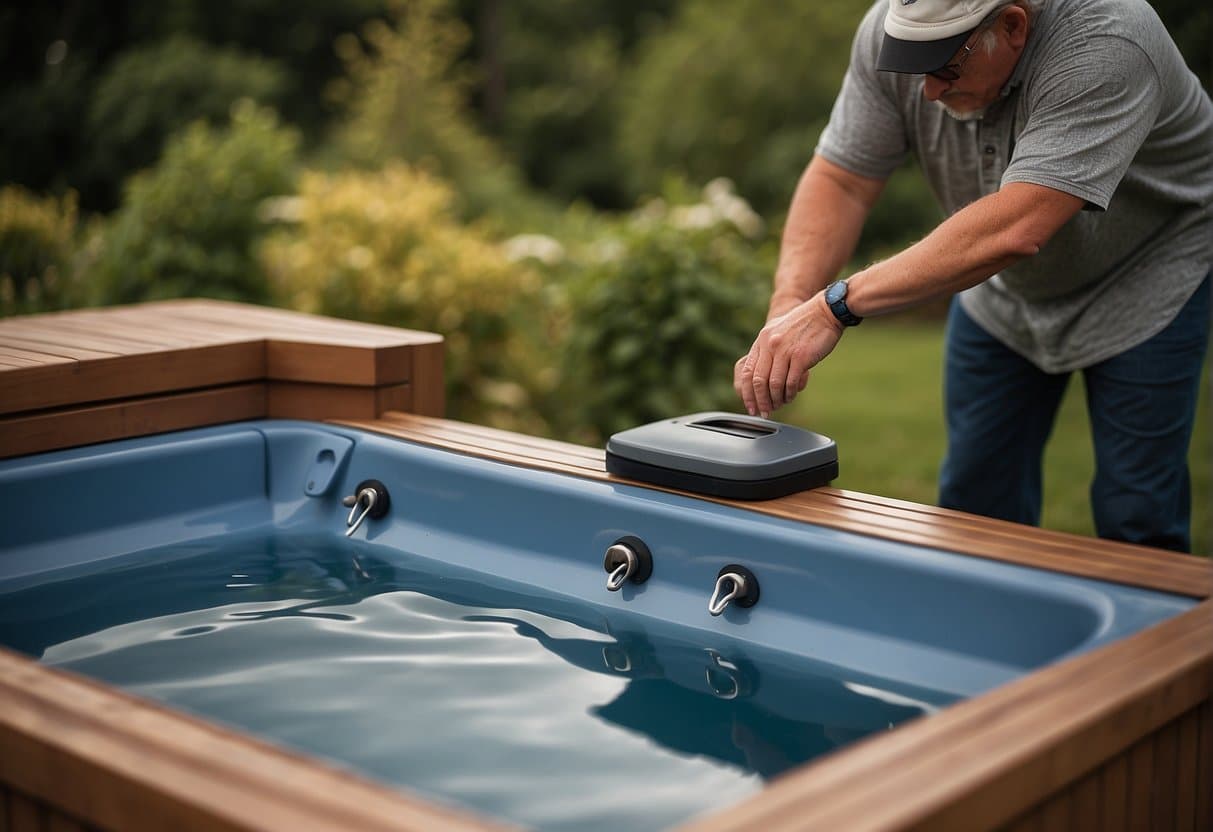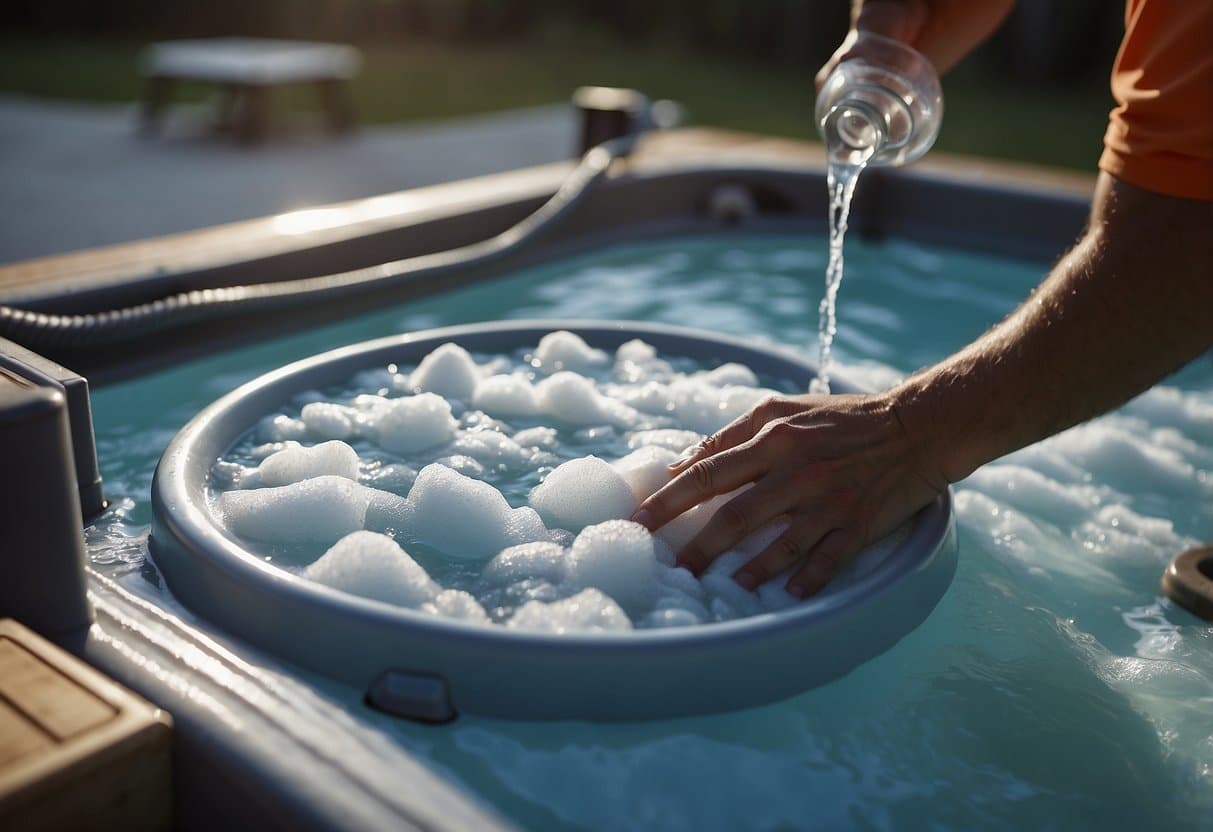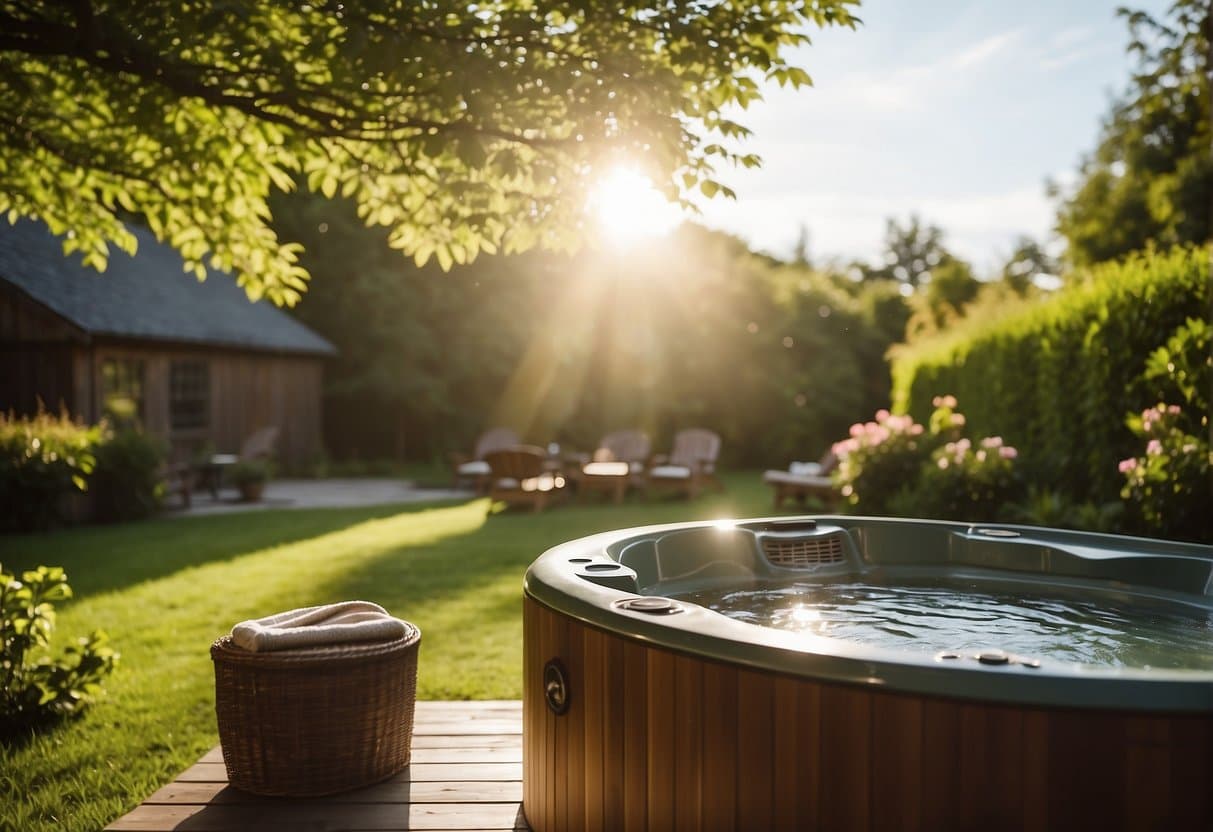Hot tubs have become increasingly popular in recent years as a relaxing home escape or gathering spot for friends and family. And being so, hot tub tips can save you time and money on your current unit. Whether you’re a proud owner or simply considering purchasing a hot tub, there are essential tips and maintenance techniques to ensure that your investment is enjoyable and long-lasting. This article provides valuable insights into maximizing your hot tub experience, from water care to energy efficiency, as well as safety precautions to protect your loved ones.
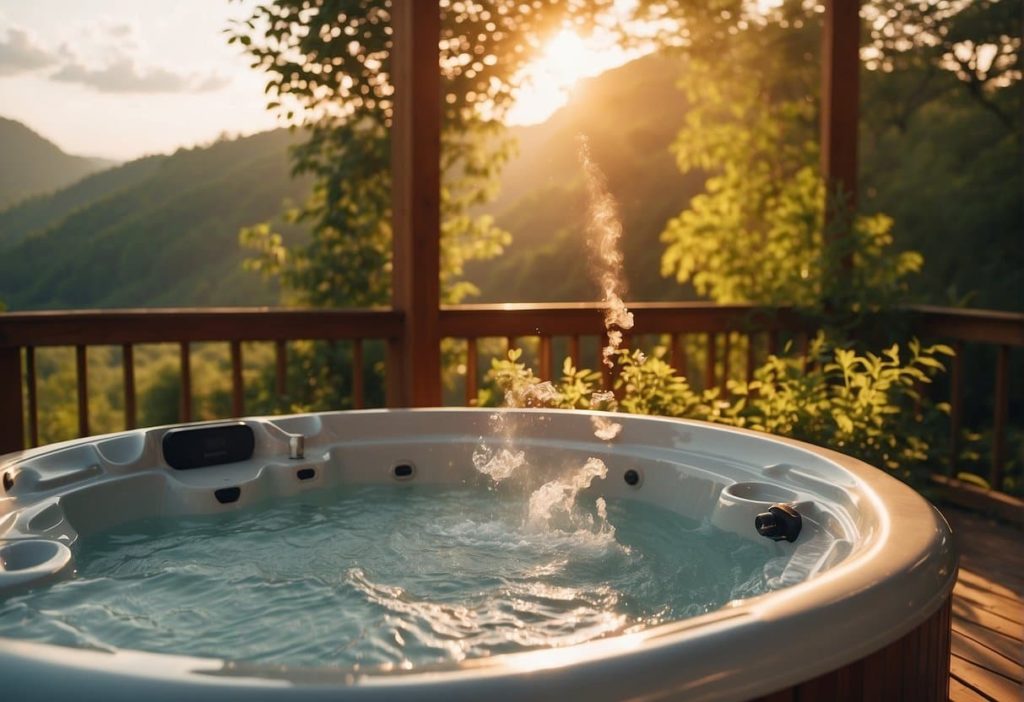
Selecting the right location for your hot tub is crucial to its efficiency and the overall appeal of your surroundings. The ideal space must ensure ample ventilation, structural support, and convenient access to utilities. Besides the installation basics, understanding the significance of proper water balance, sanitation, and filtration is indispensable in maintaining your hot tub’s prime condition.
An array of accessories can elevate your hot tub experience, such as waterproof Bluetooth speakers for entertainment, a cover lifter for easy removal and storage, or ergonomic spa pillows for maximum comfort. Additionally, a mindful approach to conserving energy and establishing a safe environment for children will play an essential role in optimizing your hot tub experience. As we delve into these key aspects, let this comprehensive guide empower hot tub enthusiasts with the necessary tools to create a rejuvenating and rewarding experience.
Choosing the Right Hot Tub
Types of Hot Tubs
When selecting a hot tub, consider the various types available to suit your needs. Hot tubs differ in material, size, and functionality. Here are the main categories:
- Inflatable hot tubs: These portable and budget-friendly options feature durable PVC shells and air blowers for easy installation and storage.
- Acrylic hot tubs: Offering a more solid construction, acrylic hot tubs boast a robust fiberglass-reinforced shell and permanently installed equipment. These are typically more expensive than inflatable options.
- Wooden hot tubs: As the name suggests, these hot tubs are constructed from wood and provide a more rustic aesthetic. They can be heated either by electricity or wood-fired heaters.
- Swim spas: A hybrid option, swim spas combine the relaxation of a hot tub with the swimming capabilities of a lap pool.
Selecting a Manufacturer
When choosing the perfect hot tub, finding a reputable manufacturer is crucial. Keep the following factors in mind:
- Quality: Look for manufacturers that use high-quality materials and construction techniques. A well-made shell is essential for durability and a long-lasting hot tub.
- Warranty: A good warranty is a strong indicator of a manufacturer’s confidence in their product. Aim for a warranty that lasts at least five years on the shell, with additional warranties for other components.
- Reputation: Research each manufacturer’s reputation by reading customer reviews and examining their industry awards, certifications, and longevity in the market.
| Manufacturer | Years in Business | Warranty (Shell) | Awards/Certifications |
| Example Co. | 20 | 5 years | ISO 9001 |
| Another Co. | 10 | 7 years | Best of Home Award |
Comparing available options will help narrow down your choices and ensure your hot tub is a worthwhile investment.
Initial Setup and Installation
Understanding Power Supply Requirements
When setting up a hot tub, it is crucial to understand the power supply requirements. Most hot tubs require a 240V or 120V connection, so check the manufacturer’s specifications for your specific model. This is essential to ensure safe and optimal performance. Moreover, always hire a licensed electrician to connect the hot tub’s electrical components to the main power supply.
Consider the following factors to understand the power supply requirements for your hot tub:
- Voltage: Identify whether your hot tub requires a 120V or 240V connection.
- Amperage: Check the amperage requirements of your hot tub to determine the appropriate circuit breaker size.
- Cable size: Ensure that you use the correct cable size for the hot tub, as specified by the manufacturer.
Placement and Insulation Options
Selecting the appropriate spot for hot tub installation is essential for both practical and aesthetic reasons. Consider the following factors when choosing a location:
- Accessibility: Ensure easy access for maintenance and water drainage.
- Weather conditions: Place the hot tub in an area that offers shelter from wind and direct sunlight.
- Surface: A level, durable surface, such as concrete, is necessary to support the weight of the hot tub.
Proper insulation is vital for hot tub ownership, as it helps in maintaining the water temperature and conserves energy. Insulation options for hot tubs are typically classified into three categories:
- Full foam insulation: This type of insulation fills the entire cabinet with closed-cell foam, offering energy efficiency and structural support.
- Partial foam insulation: As the name suggests, this type of insulation only covers some parts of the hot tub, providing a balance between energy efficiency and ease of maintenance.
- Thermal wrap insulation: This option involves wrapping the hot tub with reflective materials, which helps retain heat and prevents heat loss.
It is essential to choose efficient insulation for enhanced energy conservation and optimal performance. Each of these options offers distinct benefits, so consult your hot tub dealer or manufacturer to determine the best insulation method for your specific model.
Basic Hot Tub Care
Daily Maintenance Tasks
To ensure your hot tub remains clean and safe, it’s important to perform a few daily maintenance tasks. Listed below are the key tasks to include in your maintenance schedule:
- Check sanitizer levels: Using test strips, monitor the levels of sanitizer (e.g., chlorine or bromine) in your hot tub water. Adequate sanitizer levels are crucial for maintaining water balance and preventing harmful bacteria growth.
- Skim the surface: Use a skimmer to remove debris, such as leaves and insects, from the water’s surface. This helps reduce the strain on the filtration system and keeps the water clean.
- Monitor water temperature: Make sure the water temperature remains within a safe range (typically between 100°F to 104°F).
Periodic Water Testing
Water chemistry plays a significant role in maintaining a healthy and safe hot tub environment. It is essential to test the water at least once a week, paying close attention to the following components:
| Component | Ideal Range | Importance |
| pH | 7.2 – 7.8 | Regulates sanitizer efficiency and prevents corrosion |
| Total alkalinity | 80 – 120 ppm | Stabilizes pH levels and prevents scaling |
| Sanitizer | Varies depending on the type | Controls bacteria, viruses, and algae growth |
You can use test strips or a liquid test kit to quickly and easily measure these components. Adjust the water chemistry as needed to maintain a perfect balance.
Regular Filter Care
The hot tub filter plays a crucial role in keeping the water clean and free of contaminants by removing dirt, debris, and oils. To maintain optimal performance, it is essential to regularly attend to hot tub filter care:
- Rinse the filter: Every two weeks, remove the filter and rinse it with a garden hose to remove debris lodged between the pleats. Make sure you do not use a high-pressure hose, as it may damage the filter.
- Clean the filter: Once a month, soak the filter in a filter cleaner solution to break down accumulated oils and other contaminants. Rinse thoroughly before reinserting it back into the hot tub.
- Replace the filter: Every 12-18 months, replace the hot tub filter entirely with a new one. Over time, the filter loses its efficiency, and replacing it ensures that your hot tub remains clean and well-maintained.
Advanced Cleaning and Maintenance
Deep Cleaning Techniques
To achieve a thorough deep clean for your hot tub, it’s essential to start with a non-abrasive cleaner. Apply the cleaner to the hot tub’s surfaces, paying close attention to corners and crevices. Rinse thoroughly with water after scrubbing to avoid residue buildup.
Filter maintenance is another crucial aspect of deep cleaning. Begin by removing the filter from its compartment and giving it a thorough rinse with water to dislodge any dirt or debris. Next, soak the filter in a filter-cleaning solution for the recommended duration. Finally, rinse it again before reinstalling it in the hot tub.
For an even deeper clean, consider the following steps in addition to the initial process:
- Purge the plumbing system: Use a designated hot tub plumbing cleaner to eliminate stubborn buildup and residue within your spa’s circulation system.
- Wipe down the waterline: Use a clean cloth or sponge to gently scrub along the waterline to remove any remaining grime.
Effective Draining and Refilling
Draining and refilling your hot tub should follow a series of specific steps to ensure effectiveness. Here is an outline to facilitate this process:
- Turn off the electrics: Before draining, ensure the hot tub’s electrical components are turned off and disconnected.
- Locate the drain valve: Drain valves are often situated at a tub’s base. Sometimes, they may require a hose attachment to direct water away from the immediate area.
- Attach a hose filter: By connecting a hose filter to your garden hose, you prevent any dirt or debris from entering your hot tub when refilling it.
- Drain the hot tub: Open the valve and allow water to drain away, which can generally take a few hours, depending on your hot tub model.
- Clean the shell: With the hot tub drained, take this opportunity to clean the empty shell using a non-abrasive cleaner.
- Refill: Once clean, remove the hose filter, begin refilling the hot tub with fresh water, and monitor the fill level to ensure it reaches the correct volume.
- Reconnect electrics: With the hot tub refilled, it’s now safe to reconnect the electrical components and turn on the hot tub.
Remember to schedule your draining and refilling every three to four months, depending on usage and water quality. Following these steps will not only ensure a clean and hygienic hot tub but also extend its lifespan for years to come.
Water Chemistry and Treatment
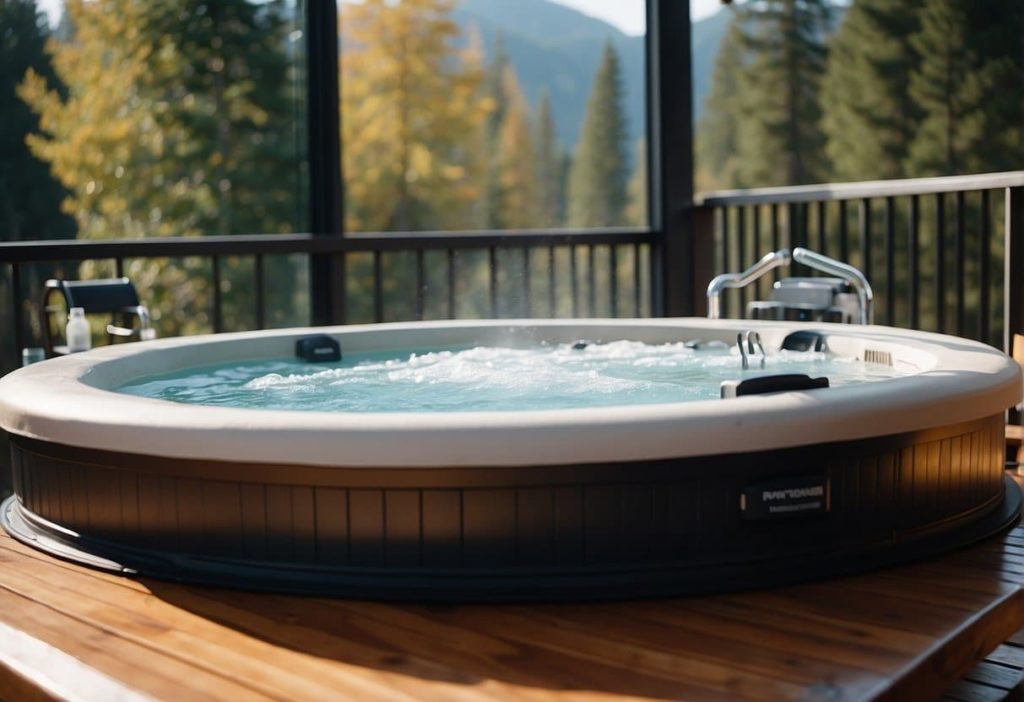
Balancing PH and Alkalinity
Achieving the perfect water chemistry in a hot tub is essential for both the comfort and safety of the users. Balancing pH and alkalinity is a crucial aspect of this process.
The pH level is a measure of how acidic or alkaline the water is. Optimal pH levels for a hot tub should be between 7.4 and 7.6. If the level is too low or high, it can cause skin and eye irritation, as well as damage to the hot tub components. To adjust the pH, use a pH increaser to raise the level, or sodium bisulphate to lower it.
Alkalinity is the water’s ability to resist changes in pH. It acts as a buffer, preventing sudden fluctuations. To maintain proper alkalinity levels, which should be between 100 and 150 ppm, use an alkalinity increaser such as sodium bicarbonate.
Remember to test the water frequently and make necessary adjustments to keep your hot tub in optimal condition.
Using Chemicals and Sanitizers
Sanitizing hot tub water is vital for maintaining a clean and safe environment. Two common sanitizers used in hot tubs are chlorine and bromine.
| Sanitizer | Pros | Cons |
| Chlorine | Fast-acting and widely available | Can produce a strong odor |
| Bromine | Lower odour, less skin irritation | Slower acting, more expensive |
To choose the best sanitizer for your hot tub, consider factors such as the frequency of use, personal preference, and cost.
In addition to sanitizers, consider using a shock treatment to keep the water crystal clear and odour-free. This process oxidizes contaminants and helps restore water clarity. There are two types of shock treatments: chlorine-based and non-chlorine. Choose the one that best suits your hot tub’s specific needs.
Finally, it is essential to regularly test your hot tub’s water chemistry, as maintaining the right balance contributes to its longevity and improves the overall bathing experience.
Troubleshooting Common Issues
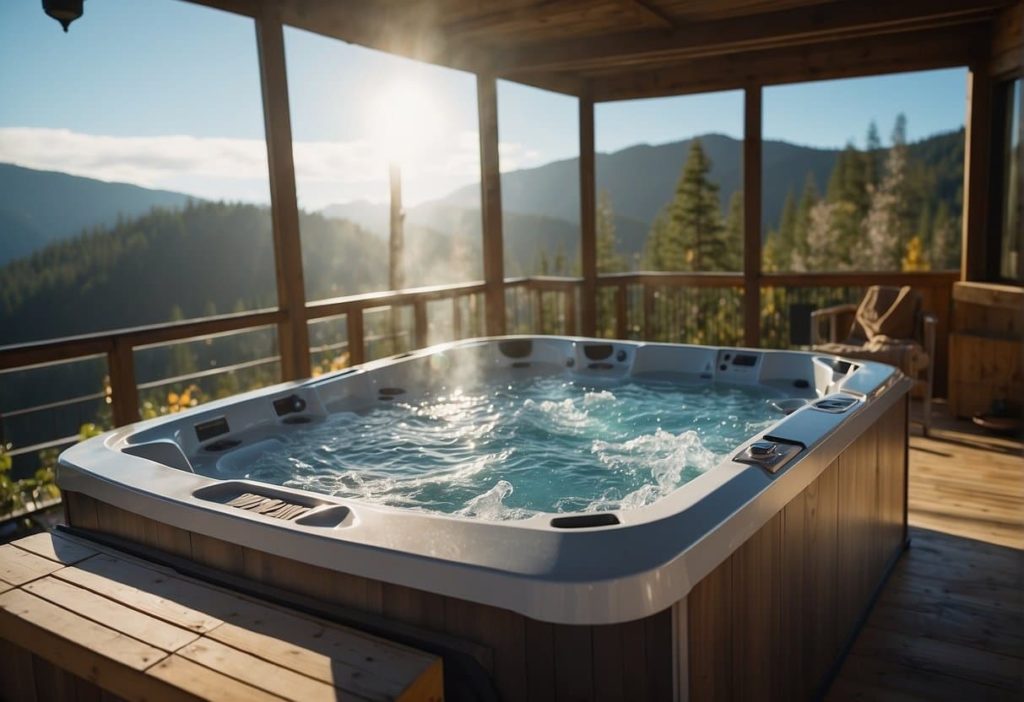
Handling Cloudy or Foamy Water
Cloudy or foamy water in a hot tub is often a result of contaminants such as body oils, lotions, and other organic materials entering the water. To address this issue, follow these steps:
- Test the water: Check the pH and sanitizer levels using a test kit. Ensure they are within the ideal range. The recommended pH level for hot tubs is between 7.2 and 7.8.
- Shock the water: Use a non-chlorine shock or an oxidizing shock to break down contaminants and restore water clarity.
- Clean the filter: Remove and clean the filter cartridge since it can often trap scum and debris. Rinse it thoroughly and let it dry before reinserting it back into the hot tub.
- Use a clarifier: Add a water clarifier to help clump small particles together, making it easier for the filtration system to remove them.
Addressing Unpleasant Odors
Unpleasant odours in a hot tub often occur due to a buildup of bacteria or algae, which can be eliminated by maintaining proper sanitation. Follow these steps to prevent and address foul smells:
- Sanitize regularly: Ensure that the sanitizer levels are maintained within the ideal range, and shock the water every week to eliminate algae and bacteria.
- Clean the filter: As noted earlier, a clean filter is essential to maintaining water quality. Clean the filters as needed, and replace them when they become hard or discolored.
- Clean the hot tub surfaces: Use a suitable surface cleaner to remove any organic residues or biofilm that might contribute to the growth of bacteria and algae, which can produce unpleasant odours.
Dealing with Hard Water Problems
Hard water issues in a hot tub arise when there is a high concentration of calcium and other minerals, often causing a buildup of scale and cloudy water. These problems can be managed by the following methods:
- Test the water hardness: Determine the level of total dissolved solids (TDS) in the water. If TDS levels are above 1,500 parts per million (ppm), it’s time to address the hard water problem.
- Soften the water: Use a water softener to lower the calcium levels and prevent scaling. This will help maintain the efficiency of the equipment and prolong the life of your hot tub.
- Prevent scale buildup: Use a stain and scale remover to help prevent mineral deposits from forming on surfaces and in the plumbing.
- Regularly check and clean components: Monitor the tub components for any signs of scale buildup and clean them as necessary to maintain optimal performance.
Following these troubleshooting steps should help maintain the quality of your hot tub water, ensuring a comfortable and enjoyable experience.
Enhancing the Hot Tub Experience

Optimizing Water Temperature
The ideal hot tub temperature can vary depending on personal preferences and the specific activity (relaxation, socializing, or hydrotherapy). In general, the recommended temperature range is between 100°F (38°C) and 104°F (40°C). It is essential to maintain a consistent temperature to ensure a pleasant and safe experience.
To optimize the water temperature, consider investing in a high-quality water circulation system. This will help distribute the heat evenly throughout the tub and reduce the risk of scalding. Additionally, a well-maintained circulation system can also prolong the lifespan of your hot tub components.
Hot Tub Features and Add-Ons
A great hot tub experience usually involves more than just warm water. Here are some features and add-ons to consider when upgrading your hot tub:
- Jets: Powerful and adjustable jets can enhance the therapeutic effects of hydrotherapy. Look for models that offer customizable settings to target specific muscle groups or areas of the body.
| Jet Type | Benefits |
| Swirl Jets | Provides a gentle, swirling massage for relaxation |
| Deep Tissue Jets | Targets deeper muscles for a more intense massage |
| Directional Jets | Can be angled to focus on a specific area of the body |
LED Lighting: Adding colourful, energy-efficient LED lights can create a soothing ambience and enhance the overall experience.- Water Features: Consider incorporating a waterfall or fountain feature for added visual appeal and relaxation benefits.
- Entertainment Options: For those who enjoy a more social experience, consider integrating a waterproof sound system or TV into your hot tub setup.
By optimizing the water temperature and investing in some additional hot tub features, you can significantly enhance your overall experience, providing a relaxing and enjoyable environment for you and your guests.
Efficiency and Sustainability
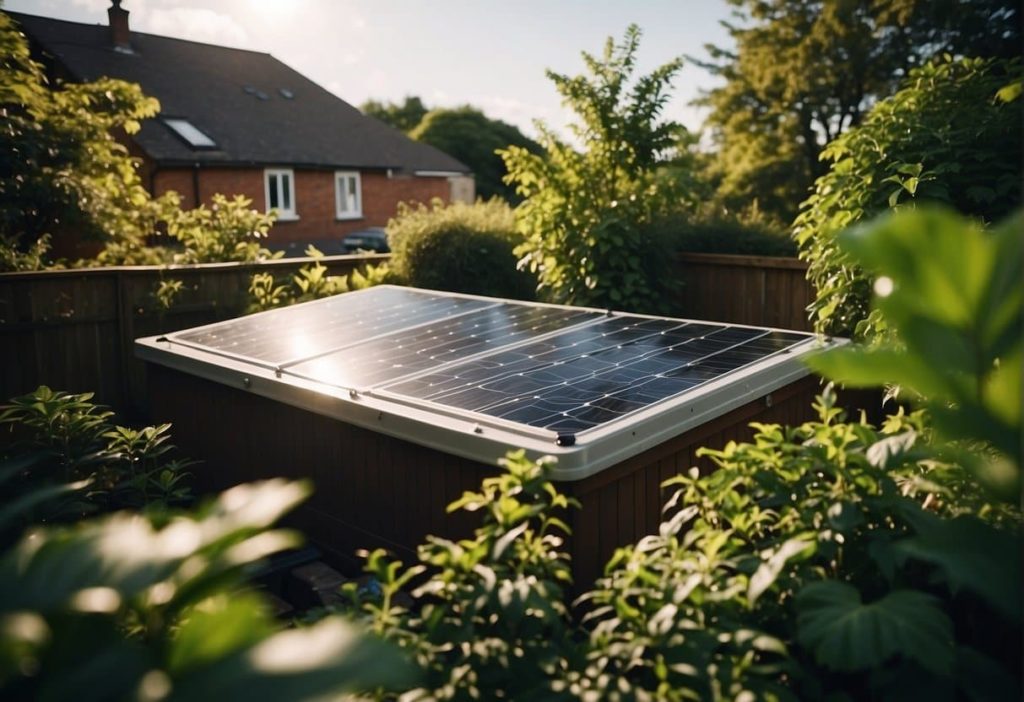
Energy Conservation Strategies
To achieve optimal performance and energy efficiency in your hot tub, consider the following energy conservation strategies:
- Use a timer: A timer helps to lower energy consumption by ensuring that the hot tub runs only when necessary. Set the timer to schedule heating during off-peak hours to reduce your energy costs.
- Monitor water level: Maintaining the appropriate water level ensures that the hot tub’s equipment will run efficiently, preventing potential damage and avoiding unnecessary electricity consumption.
- Choose the right cover: A high-quality, well-insulated cover will minimize heat loss and reduce energy consumption. Ensure the cover fits snugly to trap heat inside the tub.
- Upgrade the equipment: Energy-efficient pumps and heaters can significantly reduce the energy consumption of a hot tub. Consider upgrading your equipment to Energy Star-rated models.
Sustainable Maintenance Practices
Adopting sustainable maintenance practices is crucial for the long-term efficiency of your hot tub. Here are some key recommendations:
- Regularly clean filters: Dirty filters can make the system work harder, reducing its efficiency. Clean them regularly to ensure optimal performance and reduce energy consumption.
- Opt for eco-friendly cleaning products: Traditional cleaning chemicals can be harsh on the environment. Choose biodegradable, non-toxic alternatives to minimize your hot tub’s environmental impact.
- Install a water-saving cartridge filter: These filters are known to be more efficient in conserving water than traditional sand filters, translating to reduced water wastage and lower utility costs.
By implementing these energy conservation strategies and sustainable maintenance practices, not only will you improve your hot tub’s efficiency, but you will also be contributing to a more sustainable environment.
Seasonal Care and Storage
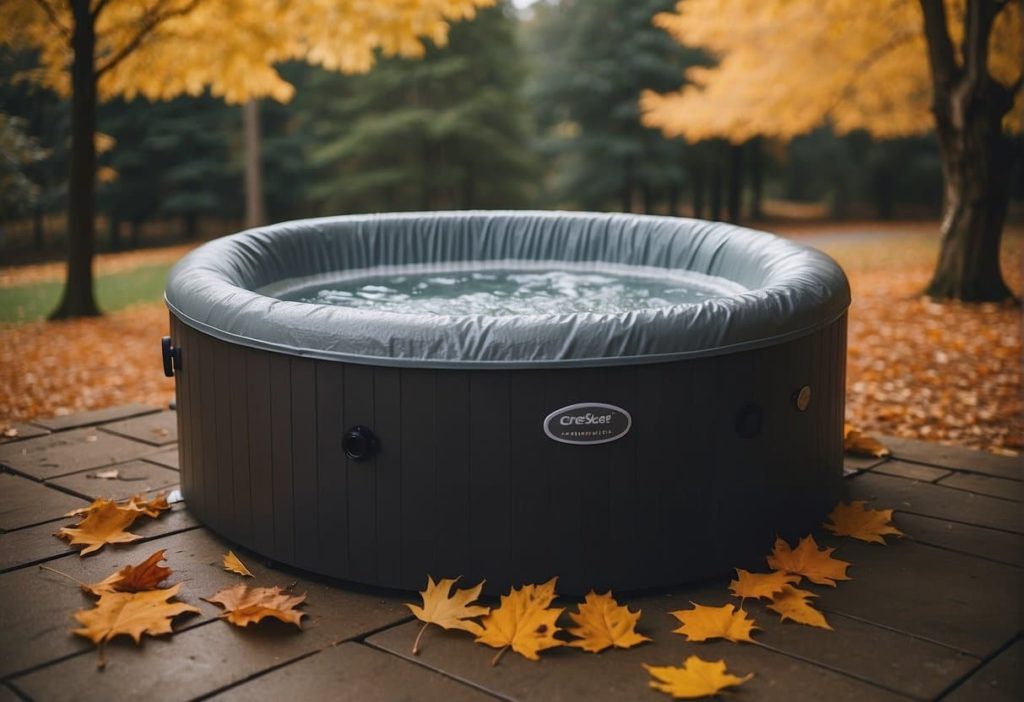
Preparing for Heavy Use Periods
As a hot tub owner, it’s essential to prepare your spa for periods of heavy use to ensure optimal performance. Follow these simple steps to maintain a pleasant and safe experience for you and your guests:
- Check the water quality: Test the water regularly and promptly adjust the chemicals as needed. Maintaining the correct pH, sanitizer (chlorine or bromine), and total alkalinity levels is crucial for bather comfort and equipment longevity.
- Inspect and clean the filters: A dirty filter can impede water flow and make the hot tub work harder. Regularly remove and clean the filter cartridge or consider investing in a spare set for continuous use during heavy guest occupancy.
- Top-up the water level: During prolonged periods of use, water may evaporate or be splashed out. Make sure to frequently check and replenish the water level to protect your pump and heater from damage.
- Create a maintenance schedule: Documenting a routine cleaning and water testing schedule can help you stay on track and prevent water issues or equipment malfunctions.
Winterizing Your Hot Tub
When winter approaches, some owners choose to temporarily close their hot tubs. Winterizing helps protect your investment during freezing temperatures, potentially avoiding expensive repairs. Follow these steps for a safe and thorough winterization:
- Drain the water: Turn off the hot tub’s power source and attach a garden hose to the drain spigot. Open the drain valve, ensuring the water runs away from the hot tub’s foundation and any nearby electrical equipment.
- Clean the shell: With the hot tub empty, give it a good cleaning using mild detergent and a soft cloth, then rinse thoroughly with water. Allow the shell to dry completely before proceeding.
- Remove and clean the filters: Take out the filter cartridges and clean them with a filter cleaner or a 10% solution of water and bleach. Rinse the filters thoroughly and store them in a dry place while the hot tub is not in use.
- Eliminate water from plumbing: Use a wet/dry vacuum to blow out any remaining water from the jets, valves, and plumbing lines. This helps to prevent freezing and damage from expanding ice.
- Secure and insulate: Place an absorbent material, like a sponge or cloth, in the bottom of the shell to collect any residual moisture. Finally, securely cover your hot tub with an insulated cover or tarp to protect it from the winter elements.
By following these seasonal care and storage tips, you can ensure your hot tub remains in top condition, ready for you to enjoy when the season returns.
Accessories and Upkeep
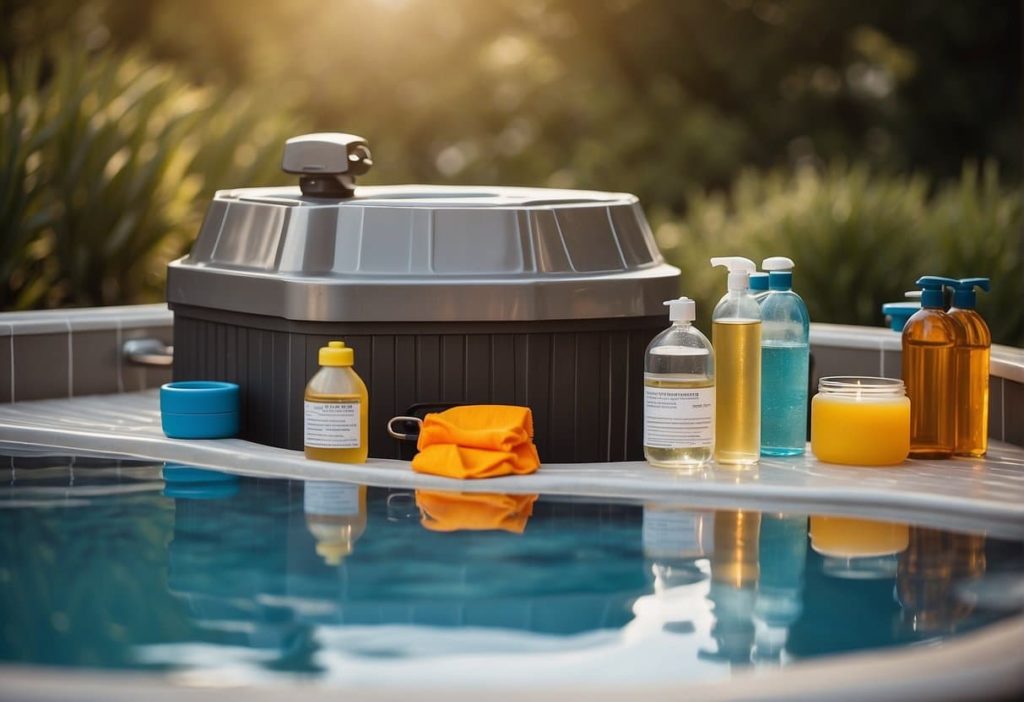
Utilizing Hot Tub Covers
A crucial part of maintaining your hot tub is having a reliable hot tub cover. It not only keeps debris and insects out of the water but also helps retain heat and prevent evaporation. Here are some tips on how to get the most out of your hot tub cover:
- Choose a high-quality cover: Invest in a durable, well-insulated cover that properly fits your hot tub.
- Clean it regularly: Wipe down the cover with mild soap and water, making sure to remove any dirt or residue.
- Inspect for damage: Periodically check the cover for signs of wear and tear, and replace it as needed.
Clever Cleaning Hacks
Keeping your hot tub clean is essential to ensure a comfortable and safe soaking experience. Here are a few easy cleaning hacks to help you maintain your hot tub:
- Tennis ball trick: Toss a tennis ball into the water when the hot tub is not in use. The fuzzy surface of the tennis ball will help absorb oils and residue, keeping your water clean. Remember to replace it the ball periodically for optimal results.
- Garden hose method: When draining your hot tub, use a garden hose as a siphon to remove debris and sediment from the bottom.
- Filter cartridge maintenance: Regularly remove and clean your hot tub’s filter cartridge to maintain water flow and ensure the filtration system operates efficiently. Here’s a quick guide to cleaning your filter cartridge:
- Turn off the hot tub and remove the filter cartridge.
- Rinse the cartridge with a garden hose, ensuring it dislodges any debris or dirt.
- Soak the cartridge in a filter cleaner solution for several hours, or according to the manufacturer’s recommendations.
- Rinse and dry the cartridge before returning it to the hot tub.
By following these simple tips, you can ensure your hot tub remains a clean and enjoyable space for relaxation.
Learning and Support
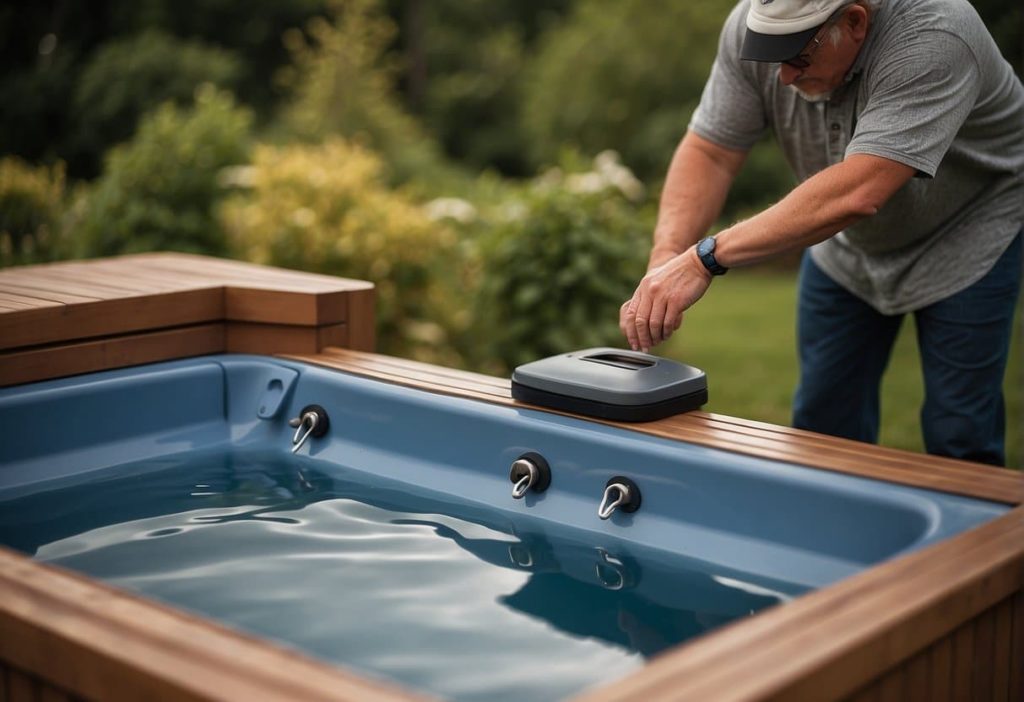
Finding Reliable Video Courses
When learning about hot tub maintenance and proper usage, it is essential to find reliable video courses. There are several online platforms which offer video tutorials, like YouTube, Udemy, and Skillshare. Keep in mind to check user reviews and expert recommendations before committing to a course.
Consider opting for courses with clear explanations, helpful visuals, and step-by-step instructions. A well-structured course outline can encompass the following topics:
- Understanding Hot Tub Components
- Basic Cleaning & Maintenance
- Water Chemistry
- Troubleshooting Common Issues
- Safety Measures
- Energy Efficiency Tips
Remember, a good video course can assist in answering questions and addressing concerns about owning and maintaining a Jacuzzi.
Consulting with Experts
There is no substitute for the guidance of an industry expert. While many resources are available online, consulting with a hot tub professional can provide tailored advice and suggestions. Some of the most crucial areas where their expertise can benefit you are:
- Customizing your Jacuzzi
- Upgrading and replacing components
- Troubleshooting complex issues
- Identifying and preventing possible hazards
Below are a few resources to find hot tub experts:
| Resource | Description |
| Local Dealerships | Many hot tub dealerships have knowledgeable staff who can provide support and guidance. |
| Hot Tub Owner Forums | Online forums offer a community of experienced users who can offer advice and share their experiences. |
| Trade Shows | Attending hot tub trade shows can provide opportunities to connect with manufacturers, retailers, and maintenance experts. |
When seeking expert advice, ensure that proper qualifications and references are provided. By using a mix of video courses and consulting with professionals, you will be well-equipped to care for your Jacuzzi and optimize its use.
Final thoughts…
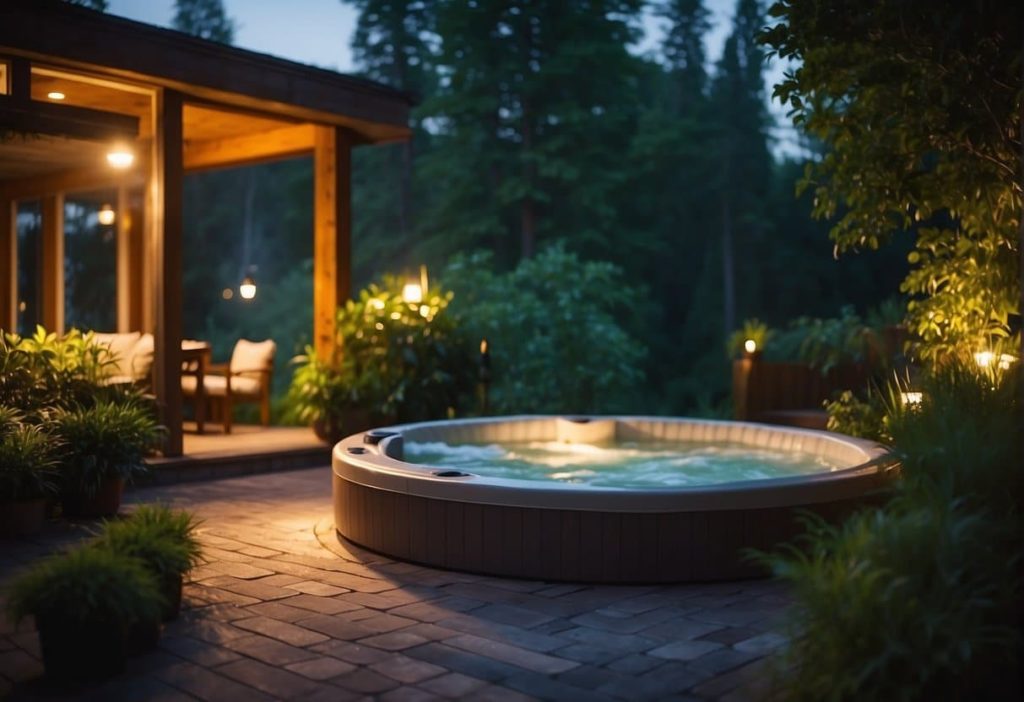
In summary, maintaining a clean and safe hot tub requires consistent effort and attention to detail. Following these essential tips will result in an enjoyable and pleasant experience for users:
- Regularly test water chemistry: Ensure that the pH, alkalinity, and sanitizer levels are within the recommended ranges. It is advised to test the water at least twice a week.
- Clean the hot tub components: Routinely clean and inspect the filter, jets, and other hardware elements. Proper maintenance prevents clogging and potential damage to the hot tub.
- Drain and refill the hot tub: Depending on usage, drain and refill the hot tub every 3 to 4 months. This removes buildup and ensures a fresh, clean environment.
- Use a cover: A well-fitted cover protects the hot tub from external dirt and debris, as well as helps retain heat and conserve energy.
| Tip | Frequency |
| Test water chemistry | At least twice a week |
| Clean components | As needed |
| Drain and refill | Every 3-4 months |
| Use a cover | Always when not in use |
Remember that following these tips and investing time in regular maintenance will prolong the hot tub’s lifespan and contribute to users’ health and well-being. Achieving and maintaining the perfect hot tub experience is possible with diligent care and attention.
Frequently Asked Questions
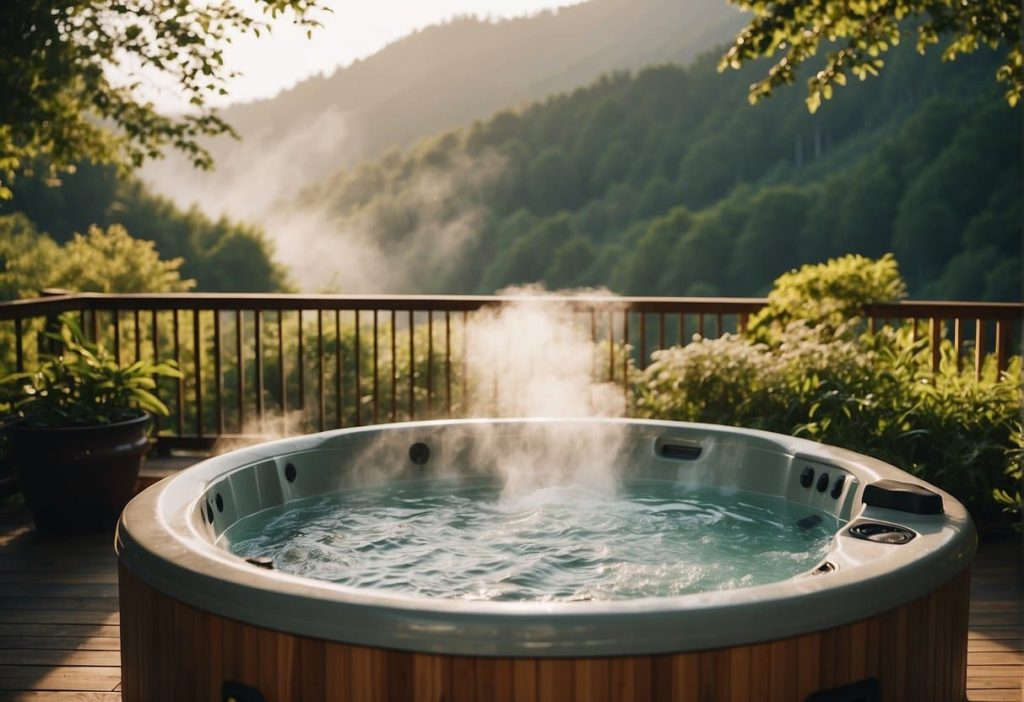
What is the ideal maintenance schedule to keep my hot tub in optimal condition?
To maintain optimal condition, it’s recommended to check the water chemistry at least 2-3 times per week and adjust the levels as necessary. The hot tub’s filter should be cleaned every 2-4 weeks and replaced every 12-18 months. A complete water change should be done every 3-4 months or as per manufacturer’s guidelines.
What steps should beginners take for basic hot tub care?
Beginners should start by reading the hot tub’s manual for specific recommendations. Basic care steps include maintaining water chemistry, cleaning and replacing the filter, and draining and refilling the tub as needed. Regular inspection of the hot tub’s components and surrounding area is also essential for detecting and preventing issues.
Which chemicals are essential for maintaining a clean and safe hot tub environment?
The most essential chemicals include sanitizer (chlorine or bromine), pH adjusters (to maintain the ideal pH range of 7.2-7.8), and total alkalinity adjusters. Additional chemicals such as water clarifiers or stain and scale inhibitors can also be used as needed, but always consult your hot tub manual for specific guidelines.
What are some effective methods for maintaining a hot tub without the use of chemicals?
For a more natural approach, consider using mineral-based sanitizer systems, ozonators, or saltwater systems. Regularly cleaning and changing the water is also crucial for maintaining a clean environment. However, some chemicals may still be required to balance pH and alkalinity levels.
How can I enhance my hot tub experience for maximum enjoyment?
To enhance your hot tub experience, consider investing in accessories such as spa-side tables, floating trays, waterproof Bluetooth speakers, and aromatherapy scents. Adjusting the hot tub’s jet settings and lighting can also create a more enjoyable and personalized experience.
Is it advisable to run hot tub jets continuously, and what impact does it have?
Running hot tub jets continuously is not necessary and can increase energy consumption. It’s recommended to run jets during specified filter cycles (usually 2-4 hours per day) to keep the water clean. However, certain spa manufacturers may suggest continuous operation at a lower speed, so always consult your hot tub manual for guidance.

